Over-85 Population in U.S. to Double by 2020, Study Says
- Share via
WASHINGTON — The good news in the latest government report on the elderly is that, thanks to medical advances and healthier living habits, the number of Americans older than 85 will more than double in the next 25 years.
The bad news is that the “oldest old,” as this group has become known, may need massive amounts of expensive medical care that will severely strain the nation’s already overburdened health care system.
“The oldest old are really booming; they are the ones putting the strain on the services,” said Kevin Kinsella, a co-author of the study released jointly Monday by the Census Bureau and the National Institute on Aging.
Today there are 3 million Americans who are older than 85. About 30% of them have Alzheimer’s disease and 24% of them live in nursing homes. In 2020 there will be 7 million of the oldest old. Many of those who do not live in nursing homes will require care from children who themselves are elderly.
Experts cannot agree whether to worry about the burden that the burgeoning over-85 population will place on society or to rejoice in the advances of an ever-healthier and more educated senior population.
“Many of tomorrow’s homeless may be older Americans who can’t find adequate shelter or health care or income,” warned Dr. Edward Schneider, dean of the Andrus Gerontology Center at USC.
In contrast, Richard Suzman, head of the office of demography at the National Institute on Aging, predicts that further medical breakthroughs--such as in commonplace knee and hip replacements, for example--will allow millions of people to lead healthy and vigorous lives into their 90s.
California will do more than its share in contributing to the nation’s population of the oldest old. The Census Bureau estimated that the state’s over-85 population, now at 323,000, would reach 809,000 in 2020.
The oldest old group is growing significantly faster than the elderly as a whole--who in turn are growing much faster than the entire population. The Census Bureau expects the 65-and-older age group, now 33 million, to exceed 53 million in 2020.
“California as usual will lead the way,” Schneider said. Its 3.3-million elderly population will grow to 6.6 million in 2020, according to the Census Bureau and the National Institute on Aging.
Making up less than 13% of all Americans, this group consumed about one-third of all health spending last year, about $330 billion of the nation’s $1-trillion health tab.
Recent studies suggest that disability may already be declining among the oldest old. Fewer of them need someone else’s help with the routine activities of daily living; more of them--an estimated one-quarter to one-third--live in the community without any special help.
Larry Crecy, executive vice president of the National Caucus and Center on the Black Aged, gives a large share of the credit to Medicare and Medicaid, the government health insurance programs for the elderly and the poor.
*
Analysts have found a strong correlation between educational achievement and good health later in life. They are encouraged that 25% of the baby boom generation, born from 1946 to 1964, have college degrees, compared to less than 9% of today’s 65-and-over population.
Baby boomer women in particular should be more affluent than their mothers, many fewer of whom worked outside the home. They will be much more likely to have their own income from Social Security and private pensions, instead of depending on their spouses.
Schneider acknowledged that legions of boomers, flush with good health from decades of proper diet and exercise, will be enjoying life well into their 90s. But he said that he fears their ranks could be overwhelmed by far greater numbers who are frail and ill.
More to Read
Sign up for Essential California
The most important California stories and recommendations in your inbox every morning.
You may occasionally receive promotional content from the Los Angeles Times.













